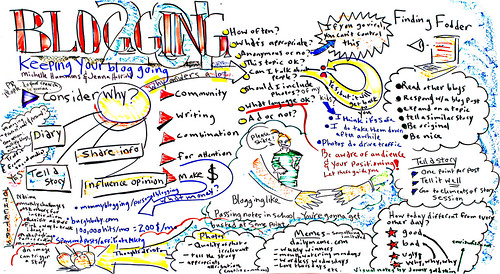How To Write A Data Science Blog
The Art of Science Blogging: How to Write a Blog That Non-Scientists Will Read

There's a good chance that at some point in your life you will be faced with the task of writing a blog post. For some, this may be an inconsequential request, but for many blog writing is a task that brings out the internal procrastinator.
To add another layer of discomfort, there are topics that lend themselves to blogging—travel, cooking, and so on—but most would admit that science, particularly of the complicated variety, is not generally among them. Making complex science approachable and interesting to the internet public can be a challenge.
But blog writing doesn't have to be a drag. It's empowering to share your work and ideas with the wider world. Blogging is a great way to communicate the importance of your research to an audience that may otherwise completely overlook it. Making your science more accessible will make it more widely understood and increase its value in the eyes of the public. That is certainly a reward worth going through the effort of writing a blog post. Luckily, like most skills, science blogging gets much easier with practice. This post will cover tips and tricks to get the most out of science blogging.
1. Know Thy Audience

Audience is the best place to begin when thinking about blog writing. It is also the best place to end. A good blog post is geared towards the audience from the header line to the sign off.
Before you begin writing, define your audience. What does the reader know? What do they need to be told to make sense of what you are saying? Out of all these questions, the most important is: Why should the reader care? This should be clarified as soon as possible in your post—either in the first sentence or, even better, in the title.
The answer to this question is the reason the reader will stay engaged with the science you are writing about. The world is crazy-busy, and we all have more urgent things to do than read blog posts. Unless, of course, the blog post is going to make the rest of our hectic lives easier. It is vital that you tell the reader why they should bother reading your post before they have a chance to get distracted by a new email or YouTube cat video.
2. Decide What to Write About
Being simultaneously entertaining and informative is a tall order. If you are searching for inspiration, BuzzSumo and SEMRush are tools that take a keyword and return trending topics. Speaking of keywords, you might want to identify a handful to use in your post to help it get seen by your desired audience. Here's a list of free tools for identifying keywords.
3. Get Words on the Page
After you have put yourself completely in the shoes of the reader, answered the "why do we care" question, and understand what background you need to provide, the next step is to start writing.
For some people, this involves creating a detailed plan. For others, the most effective course of action is putting a stream of consciousness onto a page, then going through an intense course of editing. Do whatever works best for you—the evidence is split on whether or not planning is worth the time it takes.
Here are a few simple pointers to keep in mind when writing the body of your blog post:
- Voice: Defining your audience will help define your voice. Be sure to use a voice that will appeal to the people that you want to address and won't drive them away. If you use informal writing in an academic publication, you'll risk losing ethos. Conversely, if you use formal writing in a blog post, you'll risk seeming stuffy or not engaging your reader.
- Vocabulary: It's time to discuss public enemy number one of science blogging, and science communication in general—jargon. If you are reading a blog, and the author mentions raster data stored in a numpy array without explaining it, and you don't know what that means, you're going to google "raster," then get distracted by the internet. We all know how that goes. If you aren't sure how your writing comes off, there are some online tools that can help, like The Hemingway Editor. When given a section of text, The Hemingway Editor will tell you what grade level you are writing for. It even points out excessively complex sentences.
- Grammar: Using proper grammar ensures that readers can easily follow your ideas. It also keeps your credibility intact. Write in complete, short sentences. Avoid the passive voice (the Hemingway Editor can help with this too). The organization that you're writing for might also have a preferred grammar style like MLA, AP, or Chicago or even their own organizational style guide.
- Length: Most experts recommend posts between 1,000 and 2,000 words, with 300 being the absolute minimum. This Read-O-Meter tool tells you the read time for your blog.
4. Tell a Story

Since the beginning of humankind, we have communicated and learned through stories. Conveying information through a narrative will make your reader more likely to remember what you've written and keep them engaged. Did something go wrong? Tell us about it. Was there a funny or interesting miscommunication? Perfect. Inject your personal experience to keep the reader entertained as you educate.
5. Balance Between Scientific Accuracy & Engaging Writing
On that note, here is another question to think about: how far down the rabbit hole of detailed science do you need to go for your reader to understand what you are saying? The answer is usually less far than you might expect. Unlike in most science writing, the reader of a blog post doesn't need (or want) to know your exact methods, the details of your study area, or the full gamut of literature that your research is based on. Stay focused on the "why do we care" question.
6. Keep It Simple & Visually Appealing
People like things that look nice. The visual format of your blog is important! Break up your text with attention-grabbing subheadings, which also helps with your search engine optimization (SEO) ranking. Keep sentences and paragraphs short and concise. Also consider sprinkling in bullet points and lists, block quotes, images, and data visualizations when you have a large block of text. The brain is a lot more likely to stay engaged if the eyes are entertained.
7. Give Credit Where Credit is Due: Citing Sources in a Blog
If the reader needs some background info, and you don't have the time or space to provide it, links can be a great tool. One of the wonders of blog writing is that a blog is not a scientific paper—you don't need a bibliography or formal works cited. Linking to sites with a high domain authority, a website's search engine ranking, will improve your page's ranking as well.
That being said, be sure to avoid plagiarism by attributing quotes and either citing images, using images you have taken yourself, or finding images that are labeled for commercial reuse. Some sites where you can find free images to use in your post include Google Images (search for images labelled for reuse or cite the source), Unsplash, and Pixabay.
8. Find Inspiration for Your Next Post
You might want to read a few good blogs to get writing inspiration. For example, this post on Why Earth Data Scientists Are in Demand is informational without being overwhelming.
Blogging is an awesome way to introduce a new community to your research. If you love what you do, chances are other people will too. You just need to put that passion down in words simple enough for someone else to understand.
Happy blogging, and if you have any questions, leave them in the comment section below.
How To Write A Data Science Blog
Source: https://www.earthdatascience.org/blog/how-to-write-a-blog-for-science-communication/
Posted by: wilsondentelf1987.blogspot.com

0 Response to "How To Write A Data Science Blog"
Post a Comment